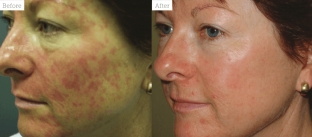Technologies based on the use of light waves of different wavelengths are used in aesthetic medicine to correct skin imperfections, as well as to treat serious diseases such as certain types of skin cancer. LED Phototherapy, Photodynamic Therapy and Intense Pulsed Light – what is the difference between them, what problems are they used to solve, and what features are characteristic of one or another type of therapy using light technologies? All this will be discussed in this article.
LED Phototherapy – features, benefits and applications
Incoherent light is also used in aesthetic medicine to treat certain problems. Non-coherent light is not as concentrated as coherent light and therefore spreads more over the surface of the treated area of the skin and even at high power it is transmitted over a shorter distance and does not penetrate the skin as deeply as coherent light.
An example of a non-coherent light source is an LED that emits non-thermal visible light waves. This therapy covers a larger area than with a laser, however, due to light scattering, the exposure time is also longer.
LED Phototherapy provides guaranteed results and is suitable for all skin types. It stimulates the regeneration and healing of the skin, increases the production of collagen, improves the function of the lymphatic system and promotes the formation of new capillaries and cell growth.
Indications for the use of LED phototherapy in aesthetic medicine
- acne;
- eczema;
- psoriasis;
- rosacea;
- pigmentation;
- aging skin;
- acceleration of healing after radiofrequency or laser therapy, peels and surgeries.
633nm light is used to smooth wrinkles and improve skin tone and texture by stimulating fibroblasts, which trigger the production of collagen and elastin; it also increases the hydration and fullness of the skin.
415nm light helps treat acne by damaging the porphyrins produced by the bacteria that cause acne and normalizing oil production.
The 830 nm wavelength light has the same effect, also reducing redness and irritation and speeding up skin healing.
Alternatively, you can use a device that does not require human intervention. It automatically affects the patient in it: the 470nm wavelength can be used to treat acne and blemishes; 660 nm – to activate cells and produce collagen and elastin, reduce redness and inflammation associated with rosacea, and 940nm – to reduce muscle and joint pain associated with arthritis.
Intense pulsed light therapy
Intense pulsed light (IPL) therapy works in the same way as laser. However, unlike the latter, intense pulsed light is a spectrum of colors of various waves – from 550 to 950 nm. As a result, different absorption target points can be selected. This use can be compared to the simultaneous use of several lasers. This is also the main advantage of such devices.
Intense pulsed light has been successfully used to treat problems such as vascular damage and pigmentation disorders, photoaging, acne, rosacea and non-melanocytic skin cancer. The results of such therapy can be improved by combining with other methods of rejuvenation.
Photodynamic therapy – features and application principle
Photodynamic therapy involves the use of a special photosensitizing agent along with exposure to specific wavelengths of light. When such a photosensitizing agent is exposed to light, oxygen is produced, which kills adjacent cells.
Photodynamic therapy is used to treat non-melanocytic skin cancer, actinic keratosis, basal cell carcinoma, Bowen's disease, and other common problems.
Methyl aminolevulinate (Metvix) is applied to the cancerous area of the skin for three hours. The tool is selective and binds only to certain types of cells – dysplastic or tumor. During these three hours, the cells are saturated with photoactive porphyrins. Upon subsequent exposure to light and interaction with such porphyrins, a chemical reaction occurs, the intermediate product of which is singlet oxygen, which destroys damaged cells. Sometimes certain amounts of the photosensitizing agent are taken up by healthy tissue, but these amounts are minimal.
The treatment uses LED radiation with a wavelength of approximately 630 nm, which covers a skin area of approximately 5x15 cm.
Photodynamic therapy is also used for skin rejuvenation, aesthetic results can be improved by combining it with mesotherapy, microdermabrasion or fractional lasers.








Add a comment